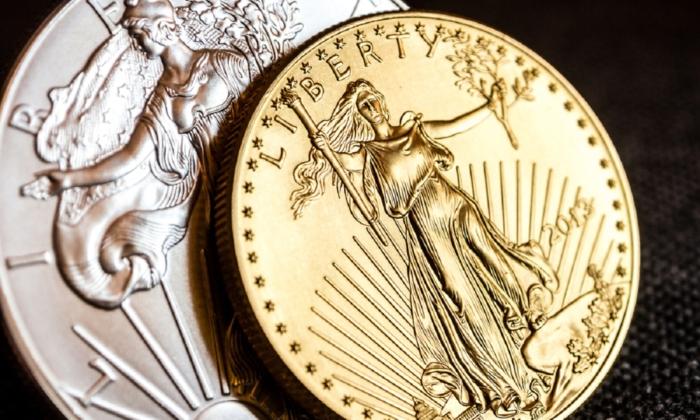Why Should You Buy Gold?
The main reason to buy gold is to diversify your portfolio and hedge against inflation. Historically, gold prices have had an inverse correlation with paper markets—gold prices rise as currency values drop because investors move to a more secure investment vehicle. Similarly, the cost of gold drops when paper currencies are strong as some investors sell their gold to buy into bullish paper markets.In practical terms, having a store of physical gold or precious metal ensures that your investments always generate income, either by earning interest or dividends via paper income or the rising gold price.
The Benefits of Investing in Gold
Gold and other precious metals offer unique benefits, making them a valuable option to consider when expanding your portfolio. But why buy gold instead of other physical assets?An Inflationary Cushion
Economic downturns result in high inflation, which limits your buying power and can cause financial distress. Since gold’s value isn’t tied directly to the economy, it remains stable, providing a buffer during harsh economic times.Traditional Hedge Asset
Most investors view gold as an excellent investment to hedge against inflation and low currency values. Historical trends indicate that as currency prices drop, the spot price of gold rises due to investors moving to a safer investment. And gold’s popularity as an investment means it gets more attention than other physical commodities, and gold prices may rise faster than other investments.Easily Tradable
There’s nothing worse than investing in a physical asset and finding it difficult to convert it back into fiat currency. Liquidity is an essential component of the safest investments. Luckily, the demand for gold means you will generally find a buyer willing to purchase when you want to sell.Almost Universal Value
Cultures worldwide recognize this valuable commodity’s appeal, allowing you to trade globally with few limitations.Collectability
One of the most appealing reasons to purchase physical gold coins is that they often have a numismatic value in addition to their gold price. Numismatic value refers to the intangible value associated with rare coins, which increases over time as coins fall out of circulation.Historical Performance
While historical trends do not indicate future performance, gold’s price has risen from under $300/troy ounce in 1971 to over $1,600/troy ounce in 2022. As more industries start to require gold for manufacturing and electronics and the mining cost continues to increase, it’s likely that these rising prices will continue.Low Long-Term Volatility
As with most precious metals, the day-to-day spot price of gold can be pretty volatile, but historically, gold has increased steadily every year. The finite supply and steady demand for gold from industries and investors keep gold’s cost relatively stable.Permanence
Gold is a remarkably durable material that doesn’t rust or decay. Archeologists have uncovered gold jewelry from 4,600 BC that remains pristine despite age. Few other physical assets, even other precious metals, can boast the same longevity, making gold a good choice for the long-term investor.Preserving Wealth
Many want to ensure the best possible future for their children, including passing on wealth from generation to generation. Gold’s longevity, rising value, and tax advantages make it a potential avenue for preserving wealth across generations.Peace of Mind
It’s easy to underestimate the psychological value we attach to gold. Knowing that you have a portion of wealth put away that has value now and in the future can be profoundly reassuring, especially in a troubled economic climate.The Risks of Gold Investing
As with any other investment, gold has several drawbacks compared to other assets. It’s up to you and your financial adviser to decide whether these risks outweigh the benefits of purchasing gold.A few risks of investing in gold include:
Is Gold a Good Inflation Hedge?
Even the best thought-out stock market or currency investment is susceptible to external factors that cause adverse price movements and can result in devastating financial losses. Hedging is like an insurance policy for your investment—it provides a layer of protection to buffer your portfolio from the vagaries of the market.Investors typically view periods of higher-than-usual inflation as a risk to their investment. This is due to the higher commodity prices and governments’ tendency to lower interest rates to encourage people to borrow and spend more money. These factors lead to decreased investment values for most assets tied to the economy, including stocks and futures.
The ideal hedge has a 100 percent inverse correlation to your main portfolio—it rises in price commensurately as your primary investment drops. Unfortunately, the perfect hedge doesn’t exist, but some commodities are popular options to protect your portfolio.
Most people buy physical gold as a hedge to protect their other investments. The price of gold has little correlation with the performance of stock markets and other paper commodities, making it an appealing candidate as a hedge investment.
In general, gold has a strong inverse correlation with high inflation periods. According to the World Gold Council, the United States only experienced eight years of higher than 5 percent inflation between 1971 and 2008. During these periods, the price of gold increased by almost 15 percent during the same time frame.
How to Invest in Gold or Precious Metal
How you decide to invest in gold will depend mainly on your goals.Many people buy physical gold and silver to store at home in an emergency. If you’re concerned about your paper financial assets, having this store of wealth should be enough to give you peace of mind, with the advantage of being liquid enough to sell whenever needed.
Where Is the Best Place to Buy Gold?
If you want to purchase physical gold, you can visit any pawn shop or gold store in your area. However, doing so has several drawbacks, including that it may be difficult to verify the purity of the metal and that you risk overpaying for coins or jewelry.What Is the Safest Way to Store Gold?
Depending on how much gold you buy, you may start storing gold in a safe at home. However, doing so opens you up to the risk of theft, especially if word gets out that you have such a valuable commodity. Still, if you decide to go with self-storage, here are some tips to keep your bullion in mint condition:· Avoid humidity and fluctuating temperatures. If possible, store your gold in a climate-controlled area. · Keep your physical gold away from other objects, as these can easily dent or scratch your precious metal. While this may not be a problem with gold bars, it will affect the numismatic value of any gold coins. · Make sure your storage solution can handle the weight. Gold is a very dense material—a standard gold bar weighs approximately 27 pounds—the more gold you buy, the stronger your storage solution needs. · If your gold bullion comes in a protective case, store it in that case.
What’s the Right Age to Start Investing in Gold?
There is no absolute perfect time to buy gold. When you start and how much you buy depends on your purchasing power, risk profile, tolerance, and needs. As with any personal finance decision, it’s best to speak to a professional wealth adviser or investor who knows your situation and can provide individual investment advice tailored to your goals.Various age brackets tend to have different investment priorities. While these are generalizations, they provide examples of why a diverse portfolio that includes gold as a financial asset can be suitable for all ages. · 18 to 30 years old: Investors at this age tend to have little disposable income and purchasing power. However, this is the perfect time to start planning for the future, and putting some money aside for stocks or any other investment now will reap great rewards. And if the gold price continues to rise, it will provide a comfortable nest egg and emergency value store. While gold is a popular precious metal, it’s not the only option—silver is more affordable and an excellent starting point for investing in physical commodities. · 31 to 40 years old: People in this category earn a stable income in established jobs. They are more risk tolerant, as they can weather losses in the stock market or other investments. Adding gold to the portfolio can alleviate risks associated with fluctuating economic conditions. · Over 40 years old: Older individuals often prefer the stable demand for gold and can afford the insurance costs of storing large amounts of gold bullion. They also have more flexibility to purchase gold securities, stocks in gold mining companies, and other gold-related options that further diversify their holdings.
Types of Gold Products
People tend to associate gold with the gold bars you see on TV and in movies, but savvy investors can find many unique ways to make investments tied to the gold price.Gold Coins and Bullion
Bullion refers to any form of certified pure or almost pure metal; in the case of gold, it refers primarily to gold bars and coins.Gold bullion is an excellent choice for buying physical gold, as it comes from a verified source—usually the U.S. Mint or other national facilities. These facilities maintain a high standard of purity, and every bar that leaves the mint has a minimum purity of 99.95 percent and a stamp and a serial number for extra security.
Gold ETFs and Mutual Funds
Physical gold bullion requires storage and insurance costs to protect your investment. An alternative is to focus on gold exchange-traded funds or mutual funds. ETFs and mutual funds work on the same principle of using investor money to own and trade bullion and then providing returns to investors.ETFs allow you to buy a fund share representing a specific, fixed amount of gold, and you can then trade these stocks without dealing with the physical hassle of bullion.





